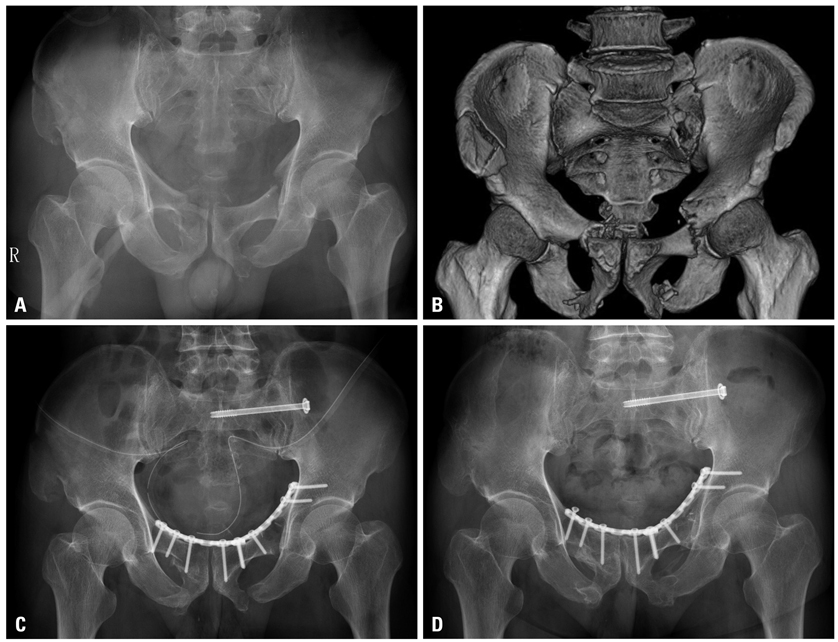Yonsei Med J.
2012 Mar;53(2):422-426. 10.3349/ymj.2012.53.2.422.
Anterior Pelvic Plating and Sacroiliac Joint Fixation in Unstable Pelvic Ring Injuries
- Affiliations
-
- 1Department of Orthopaedic Surgery, Eulji University College of Medicine, Daejeon, Korea. oskkj@eulji.ac.kr
- KMID: 1120212
- DOI: http://doi.org/10.3349/ymj.2012.53.2.422
Abstract
- PURPOSE
To analyze the effectiveness of anterior pelvic plating and subsequent percutaneous sacroiliac joint screw fixation in patients with unstable pelvic ring injuries.
MATERIALS AND METHODS
Thirty-two patients were included with twenty-one males and eleven females. The mean age was 41 years (range, 19-76). The mean follow-up period was 51 months (range, 36-73). According to AO-OTA classification, there were 11 cases of B2 injuries, 8 cases of B3 injuries, 9 cases of C1 injuries, 2 cases of C2 injuries and 2 cases of C3 injuries. In the posterior lesions, there were 20 cases of sacral fractures and 12 cases of sacroiliac joint disruptions or dislocations. Anterior pelvic plating and subsequent percutaneous sacroiliac joint fixation were performed.
RESULTS
The clinical results were 16 cases of excellent, 10 cases of good, 4 cases of moderate and 2 cases of poor functional results. The 2 cases out of 7 moderate reductions had poor functional results with residual neurologic symptoms. The radiological results were 16 cases of anatomic, 9 cases of nearly anatomic and 7 cases of moderate reduction. All patients were healed except 3 cases of nonunion at the pubic ramus. The complications encountered were 3 cases of screw loosening, 2 cases of anterior plate breakage and 1 case of postoperative infection.
CONCLUSION
In patients with unstable pelvic ring injuries, anterior pelvic plating and subsequent percutaneous sacroiliac joint screw fixation may be a useful surgical option. The radiological results and residual neurologic symptoms had effects on its functional results.
MeSH Terms
Figure
Reference
-
1. Tile M. Pelvic ring fractures: should they be fixed? J Bone Joint Surg Br. 1988. 70:1–12.
Article2. Fracture and dislocation compendium. Orthopaedic Trauma Association Committee for Coding and Classification. J Orthop Trauma. 1996. 10:Suppl 1. v–ix. 1–154.3. Denis F, Davis S, Comfort T. Sacral fractures: an important problem. Retrospective analysis of 236 cases. Clin Orthop Relat Res. 1988. 227:67–81.4. Hirvensalo E, Lindahl J, Böstman O. A new approach to the internal fixation of unstable pelvic fractures. Clin Orthop Relat Res. 1993. 28–32.
Article5. Matta JM, Saucedo T. Internal fixation of pelvic ring fractures. Clin Orthop Relat Res. 1989. 83–97.
Article6. Rommens PM, Hessmann MH. Staged reconstruction of pelvic ring disruption: differences in morbidity, mortality, radiologic results, and functional outcomes between B1, B2/B3, and C-type lesions. J Orthop Trauma. 2002. 16:92–98.
Article7. Suzuki T, Shindo M, Soma K, Minehara H, Nakamura K, Uchino M, et al. Long-term functional outcome after unstable pelvic ring fracture. J Trauma. 2007. 63:884–888.
Article8. Nepola JV, Trenhaile SW, Miranda MA, Butterfield SL, Fredericks DC, Riemer BL. Vertical shear injuries: is there a relationship between residual displacement and functional outcome? J Trauma. 1999. 46:1024–1029.9. Smith W, Shurnas P, Morgan S, Agudelo J, Luszko G, Knox EC, et al. Clinical outcomes of unstable pelvic fractures in skeletally immature patients. J Bone Joint Surg Am. 2005. 87:2423–2431.
Article10. Stocks GW, Gabel GT, Noble PC, Hanson GW, Tullos HS. Anterior and posterior internal fixation of vertical shear fractures of the pelvis. J Orthop Res. 1991. 9:237–245.
Article11. Burgess AR, Eastridge BJ, Young JW, Ellison TS, Ellison PS Jr, Poka A, et al. Pelvic ring disruptions: effective classification system and treatment protocols. J Trauma. 1990. 30:848–856.12. Kellam JF, McMurtry RY, Paley D, Tile M. The unstable pelvic fracture. Operative treatment. Orthop Clin North Am. 1987. 18:25–41.13. Keating JF, Werier J, Blachut P, Broekhuyse H, Meek RN, O'Brien PJ. Early fixation of the vertically unstable pelvis: the role of iliosacral screw fixation of the posterior lesion. J Orthop Trauma. 1999. 13:107–113.
Article14. Leighton RK, Waddell JP. Techniques for reduction and posterior fixation through the anterior approach. Clin Orthop Relat Res. 1996. 115–120.
Article15. Tornetta P 3rd, Dickson K, Matta JM. Outcome of rotationally unstable pelvic ring injuries treated operatively. Clin Orthop Relat Res. 1996. 147–151.
Article16. Sagi HC, Ordway NR, DiPasquale T. Biomechanical analysis of fixation for vertically unstable sacroiliac dislocations with iliosacral screws and symphyseal plating. J Orthop Trauma. 2004. 18:138–143.
Article17. Pohlemann T, Angst M, Schneider E, Ganz R, Tscherne H. Fixation of transforaminal sacrum fractures: a biomechanical study. J Orthop Trauma. 1993. 7:107–117.
- Full Text Links
- Actions
-
Cited
- CITED
-
- Close
- Share
- Similar articles
-
- Surgical Fixation of Sacroiliac Joint Complex in Unstable Pelvic Ring Injuries
- Operative Treatment of Unstable Pelvic Ring Injury
- Iliosacral Screw Fixation of the Posterior Pelvic Ring Using Local Anesthesia and Computerized Tomography
- Operative Treatment of Unstable Pelvic Ring Injury
- Anterior Plating and Ilio-sacral Screwing for Unstable Pelvic Injury


